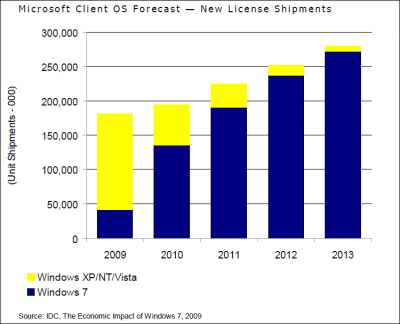Microsoft has sponsored an IDC report on the economic impact of Windows 7 [pdf]. Among the claims:
- For every dollar of Microsoft revenue from launch in October 2009 to the end of
2010 from Windows 7, the ecosystem beyond Microsoft will reap $18.52. - 19% of the global IT workforce will be working with Windows 7 by the end of 2010
- IDC expects that employment related to client operating systems will grow by more
than 300,000 new jobs or more than 30% of total growth in global IT employment in
2010 solely because of the launch of Windows 7
There is also a forecast that shows Windows 7 taking the majority of Windows client sales in 2010, and which appears to assume that Windows 8 will not be available before 2014.

Realistic figures, or some kind of fantasy? While I expect Windows 7 to take over rapidly from Vista, and to stimulate demand for PCs and laptops somewhat, I don’t believe this steadily rising graph. Cloud computing, software as a service, and growth in mobile devices, will all exert downward pressure on PC sales – even though some of those devices will still run Microsoft’s OS.
I had a conversation with Ian Osborne at Intellect while researching a supplement on software as a service. He made a good point about the unwillingness of the IT industry to embrace change. Although he thinks the cloud is changing everything, he remarked:
You’re dealing with the social phenomena of people working in ITdepartments and data centres who have invested their careers in learning how to make the other stuff work. You tend to want to cling on.
These look like “cling on” charts to me. It is an excellent point though: if the traditional IT industry is being turned on its head by the cloud, that has implications for the shape of IT employment around the world which I’ve not seen spelt out anywhere.
I don’t know if the 20-1 figure quoted by IDC/Microsoft is correct, but it is a useful reminder of how much IT ecosystem revolves around Microsoft’s platform.